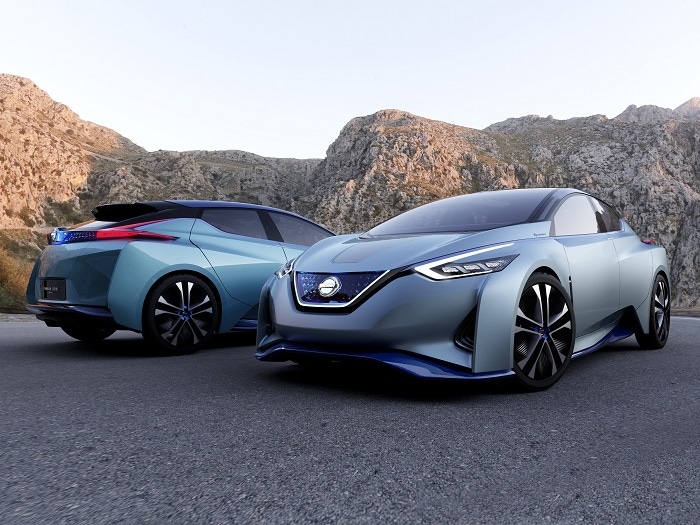Nissan IDS Concept Theoretically Doubles Leaf Range
Autonomous technology is a key element of the concept hatchback, whose cabin becomes more spacious in piloted drive as the steering wheel retracts into the instrument panel.
October 28, 2015

The IDS concept electric vehicle Nissan unveils today at the 2015 Tokyo auto show uses a battery pack that would give the car double the range of Nissan’s production Leaf EV.
The IDS hatchback has a 60-kWh battery pack, while the ’16 Leaf uses a 30-kWh pack to achieve its 107-mile (172-km) range.
Nissan does not specify the concept’s range, but says the IDS is intended to “meet the need to drive long distances.”
Many speculated the IDS would be called a Leaf concept, but it goes beyond a simple EV because it contains Nissan’s intelligent-driving autonomous technology.
“Nissan intelligent driving improves a driver’s ability to see, think and react,” Nissan CEO Carlos Ghosn says in a statement. “It compensates for human error, which causes more than 90% of all car accidents. As a result, time spent behind the wheel is safer, cleaner, more efficient and more fun.”
With intelligent driving, a manual driving mode is available, as is the ability for the car to learn a given driver’s behavior in piloted mode.
“Even when the driver selects piloted drive and turns over driving to the vehicle, the car’s performance – from accelerating to braking to cornering – imitates the driver’s own style and preferences,” the automaker says.
The technology as shown in the IDS concept continually updates a driver on traffic conditions, imminent threats on the road and, acting as a personal assistant of sorts, his schedule and nearby points of interest.
The car promotes trust in its technology via exterior lights and displays that make pedestrians and others aware of the IDS, Nissan says. For example, the silver-side body line is an LED called the intention indicator, shining red when pedestrians or cyclists are nearby. Another exterior display flashes “After You” to pedestrians.
The car’s range is aided by aerodynamic advances, says the IDS’s design director, Mitsunori Morita.
He says the height of the car’s carbon-fiber body was kept low, 54 ins. (1,380 mm), to limit drag, while “very thin” tires minimize air and roll resistance. Fins on layered wheels create tiny vortexes to smooth airflow.
Design cues include a seemingly transparent icicle pattern on the IDS grille, representing “pure and clean design.”
The car has two different interior schemes, depending on if it is in piloted-drive or manual-drive mode.
“This was something that we thought was absolutely necessary to express our idea of autonomous drive,” Morita says.
The cabin seats four but grows bigger in piloted drive, with the steering wheel retracting into the instrument panel and a flat screen appearing.
Artificial intelligence handles a driver’s voice and gestures to control various functions.
Materials in the cabin include mesh leather, illuminated by a soft light, while seats rotate for ease of conversation.
In manual drive, all seats face forward and the steering wheel appears, as do gauges and a heads-up display showing route information.
The interior is lit blue to stimulate concentration, Nissan says.
A switch called the PD Commander and placed between the front seats controls the transition from manual to piloted mode, and vice versa.
Nissan says nothing of its intention to build the IDS, but says it is on schedule to bring intelligent-driving technology to market by 2020 and will bring a piloted drive 1.0 to Japan by late 2016, for automated driving in heavy highway traffic.
By 2018 it will debut a version of the technology that can handle highway lane changes, while the 2020 version will be capable of fully autonomous driving and navigating busy urban intersections.
You May Also Like
_(2).jpg?width=700&auto=webp&quality=80&disable=upscale)


